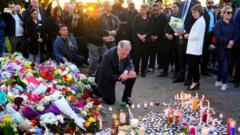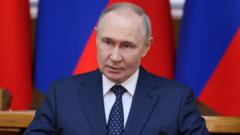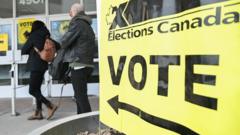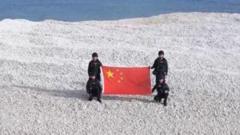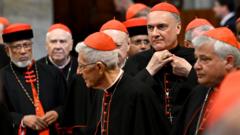With the election looming, Canada finds itself in a critical moment as citizens decide the future direction of their leadership against the backdrop of President Trump's trade wars, Liberal Party resurgence, and the Conservative Party's fading lead.
Canada's Election Day: Decisions Loom Amid Trump-Tariff Fallout

Canada's Election Day: Decisions Loom Amid Trump-Tariff Fallout
As Canada heads to the polls, voters face choices shaped by political upheaval and external pressures from the U.S. economy.
Canadians are casting their votes today for a crucial election that will determine the nation’s leadership amid economic challenges and political turmoil. The race between the Liberal Party, led by Prime Minister Mark Carney, and the Conservative Party, headed by Pierre Poilievre, is particularly tense due to the impacts of President Trump's tariffs and threats against Canada’s sovereignty, which have galvanized public opinion.
In the lead-up to the election, the Liberal Party appeared to be gaining ground, with latest polls indicating a near tie with the Conservatives. Just three months prior, the Conservatives held a significant lead of over 25 percentage points, positioning Mr. Poilievre as a likely new prime minister. However, the political landscape shifted dramatically following the resignation of former Prime Minister Justin Trudeau, allowing Mr. Carney—formerly the governor of the Bank of Canada—to position himself as the candidate capable of effectively addressing Trump’s increasingly aggressive stance towards Canada.
In addition to the main contenders, several smaller parties, including the New Democratic Party and the Bloc Quebecois, are also in the race, though they are expected to secure a minimal number of seats. The electoral system in Canada allows for the party securing the majority of seats in parliament to form the government, making today’s votes critical.
Prime Minister Carney, a centrist known for his economic expertise, has focused on presenting himself as a bulwark against Trump’s tariffs, which have targeted key Canadian sectors such as agriculture and manufacturing. His rival, Mr. Poilievre, a politician with a long career in the Conservative Party, has faced criticism for his alignment with Trump-like populism, which some voters view unfavorably amidst current geopolitical concerns.
Polling stations opened throughout the day across Canada’s six time zones, with reports indicating a steady flow of voters. Security incidents, such as a fire at a polling station in Windsor, have raised concerns but did not appear to significantly disrupt the voting process.
As Canadians prepare to choose their parliamentary representatives, they are faced with the pressing questions of sovereignty and economic stability, underscored by Trump’s antagonistic rhetoric toward Canada. With a potential shift in leadership, the implications for U.S.-Canada relations and domestic policy are profound, making this election particularly pivotal for the nation’s future.
The final results are expected to unfold through the evening, with votes counted by hand and a clear indication of the new political landscape likely by late tonight.





